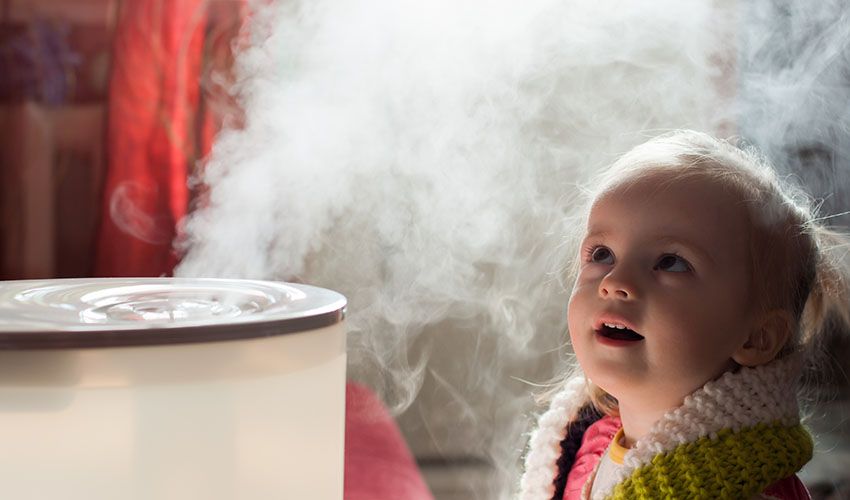Importance of Indoor Air Quality
Posted on by WestAIR Heating & Cooling

When we think about pollutants, many of us jump to an image of factories pumping smoke and toxins into the air. But what about on a smaller, more personal scale? Most of us spend more time in our own home than anywhere else, yet fail to consider the potential harm we face there. Let’s look at the importance of indoor air quality for family health.
Why Indoor Air Quality Matters
According to the EPA, the concentrations of pollutants in indoors are often two to three times what they typically are outdoors. Additionally, the EPA says that on average, Americans spend about 90 percent of their time indoors, with people who are more susceptible to pollution’s adverse effects (including children, older adults, and those with cardiovascular or respiratory disease) spending even more.
Causes/Sources
When it comes to indoor pollutants, most people are aware of secondhand smoke, radon, and carbon monoxide. Other threats to indoor air quality include:
- Combustion sources like wood, coal, and gas heating and cooking appliances
- Cleaning supplies releasing different chemicals into the air
- Building materials like insulation and pressed wood
- HVAC systems, especially if improperly maintained
- Pet hair, dander, and other allergens
- Inadequate ventilation
- Dust mites and pests
- Mold and bacteria
Outdoor air pollutants can also make their way inside the home through open doors and windows, ventilation systems, and cracks and seams. Chimney smoke can reenter and pollute the air, and volatile chemicals can sometimes enter via the water supply when cooking or showering. By simply entering the home, people inadvertently bring the soil and dust particles attached to their clothing along with them, as well as any pollutants attached to those particles.
Effects
The effects of indoor air pollutants vary both by person and based on length of exposure. Some immediate, short-term effects include:
- Irritation of the eyes, nose, and throat
- Coughing and sneezing
- Headaches, dizziness, and fatigue
- Upper respiratory congestion
- Triggered or worsening asthma symptoms, including asthma attacks
Long-term and more severe health effects include:
- Respiratory disease, heart disease, and cancer
- Nausea and vomiting
- Fever and chills
- Myalgia (muscle pain)
- Nose bleeds
- Difficult or painful breathing
If you experience any of these symptoms, contact your healthcare professional or dial 9-1-1 in case of emergency. Consult your local HVAC professional about improving your home’s air quality.
Tips
Whether we’re escaping hot and humid summer days or the bitter cold of winter, Minnesota residents spend plenty of time indoors year-round. Maintaining clean indoor air is crucial, and here are a few basic tips to get you started:
- Let in fresh air: Open windows and doors when possible and consider purchasing an air exchanger to help replace stale indoor air with during the winter.
- Clean regularly: Vacuum carpets and rugs one to two times each week and dust hard surfaces weekly.
- Wash bedding weekly and consider using dust mite-proof covers on pillows, mattresses, and box springs.
- Have your ductwork cleaned and change your filter (or clean if re-usable) monthly.
- Invest in an air cleaner to efficiently trap and remove airborne pollutants.
- Declutter your living space to avoid trapping and holding dust.
WestAIR Heating & Cooling understands the importance of indoor air quality, and we want to help keep your family safe and healthy. We offer professional duct cleaning as well as sale and service of air exchangers, air cleaners, whole house humidifiers, and replacement filters.Contact us to learn more and schedule service today.
This entry was posted in Duct Cleaning,Health Tips,Indoor Air Quality,Tips and tagged Effects of Indoor Air Pollutants, Effects of Indoor Air Quality, Effects of Poor Indoor Air Quality, Family Health, Family Safety, Heating, Heating System, Home Heating, Home Safety, Homeowner Education, Homeowner Tips, HVAC Safety, Importance of Indoor Air Quality, Indoor air, Indoor Air Pollutants, Indoor air quality, Indoor air quality solutions, Indoor Air Quality Tips, Winter
Ready to Replace: The Benefits of a Furnace Upgrade
Posted on by WestAIR Heating & Cooling

How old is your furnace? According to Consumer Reports, a furnace’s average life expectancy is 15 – 20 years (depending on the fuel type). Age is just one indicator that it’s time to replace your heating system, and doing so can do more than just ensure a cozy home all winter. Read on to learn more about the benefits of a furnace upgrade.
Increased Energy Efficiency
Modern furnaces offer significantly more efficiency than older ones, which ultimately means lower utility bills. This is measured by the system’s annual fuel utilization efficiency (AFUE) – the amount of the system’s annual energy consumption that actually produces heat. Older systems score between 56 percent and 70 percent AFUE, meaning only 56 to 70 percent of the energy consumed becomes heat for the home. Modern high-efficiency heating systems offer 90 percent to 98.5 percent AFUE, helping you use less and save more.
Compatible with Programmable Thermostat – More Savings
Programmable thermostats can save you up to 33 percent on annual heating and cooling costs. You can schedule temperatures ahead of time, so the system automatically turns down when you’re away to save energy and back up when you’re at home for comfort. Properly used along with your new energy-efficient furnace, a programmable thermostat can help you maximize your savings.
Optimal Comfort Throughout the Home
Advanced technology in today’s furnaces helps provide stable, even temperatures throughout the home, eliminating cold spots and ensuring comfort.
Some modern features and benefits:
- Zoning systems let you regulate the temperatures in each individual room, making sure the heat is utilized how you want.
- Variable-speed operation means the blower motor has multiple speed settings. It will work at high capacity during periods of extreme cold to circulate more warm air throughout the house, and low capacity on more mild days to use less energy. Older systems have fixed-speed motors that operate at full capacity whenever they run.
- Two-stage furnaces will operate in the first stage (about 65 percent of full capacity) until outside temperatures drop low enough, in which case it will kick into stage two and produce more heat to fulfill the additional requirements. As a result, these systems enhance efficiency and provide a steady flow of warm air for comfort on those extra-cold days.
Improved Safety
Due to normal wear and tear over time, an older furnace can develop a crack in its heat exchanger and leak poisonous carbon monoxide (CO) into the home. Common signs of a CO leak include:
- Weak, flickering, and/or yellow burner flame
- Soot streaks near furnace
- Moisture on windows, walls, or other cold surfaces
- Rusting on flue pipes/other pipe connections or appliance jacks
- Small water leak at base of chimney, vent, or flue pipe
Signs of human exposure can be mistaken for common illnesses:
- Flu-like symptoms
- Headaches
- Nausea
- Disorientation
- Burning feeling in nose/eyes
If you notice any of these signs of CO poisoning, contact your local HVAC specialist immediately. Installing a new furnace will help keep your home feeling cozy through the winter without putting your family in danger.
Better Indoor Air Quality
Your HVAC system is also responsible for the air quality of your home, and keeping a clean air filter is key. However, even with a clean filter, an older furnace can cause excessive dust, allergens, and dry, stale air in your home.
Enhanced Reliability
Frequent issues and expensive repairs to your furnace add up quickly, and they also leave your home with insufficient or no heat until fixed. While you should have your system serviced annually, having to call for a repair shouldn’t be a regular occurrence. A new furnace gives you the peace of mind that your family will be comfy all winter long.
While important, keeping your home warm is only one of the benefits of a furnace upgrade. We rely on our home’s heating system a lot here in Minnesota, so it’s important to make sure yours is up to the task. Don’t wait until it’s too late! Have your system inspected today and see if this is the year you replace.
WestAIR installs high-efficiency Rheem furnaces because they use advanced, state-of-the-art technology to offer the best in energy-efficient home heating. From HVAC service to system replacements, our experts are here for all your heating and cooling needs.Contact us for more information.
This entry was posted in Furnace,Heating,Indoor Air Quality,Tips,Winter and tagged Benefits of a Furnace Upgrade, Energy efficiency, Furnace replacement, Furnace replacement from Rheem, Furnace Upgrade, Heating, Heating System, Heating System Upgrade, High-Efficiency Furnace, Home Heating, HVAC Upgrade, Indoor air quality, Rheem Furnaces, Rheem Pro Partner, WestAIR furnace replacement, Winter
Subscribe to Our Blog
With RSS feeds, you don't have to visit our site everyday to keep up to date. Simply subscribe to our blog via RSS or Email and our posts will come to you!
Search Blog Posts
Categories
Archives
- April 2024 (1)
- February 2024 (1)
- January 2024 (1)
- February 2023 (1)
- January 2023 (1)
- December 2022 (1)
- November 2022 (1)
- October 2022 (1)
- September 2022 (1)
- August 2022 (1)
- July 2022 (1)
- June 2022 (1)
- May 2022 (1)
- April 2022 (1)
- March 2022 (1)
- February 2022 (2)
- December 2021 (1)
- November 2021 (1)
- October 2021 (1)
- September 2021 (1)
- August 2021 (1)
- July 2021 (1)
- June 2021 (1)
- May 2021 (1)
- April 2021 (1)
- March 2021 (2)
- January 2021 (1)
- December 2020 (1)
- November 2020 (1)
- October 2020 (1)
- September 2020 (1)
- August 2020 (1)
- July 2020 (1)
- June 2020 (1)
- May 2020 (1)
- April 2020 (1)
- March 2020 (1)
- February 2020 (2)
- November 2019 (1)
- August 2019 (2)
- June 2019 (1)
- May 2019 (1)
- April 2019 (1)
- March 2019 (1)
- February 2019 (1)
- January 2019 (1)
- December 2018 (1)
- November 2018 (1)
- October 2018 (1)
- September 2018 (1)
- August 2018 (2)
- July 2018 (1)
- May 2018 (1)
- April 2018 (1)
- March 2018 (1)
- February 2018 (1)
- January 2018 (1)
- December 2017 (3)
- November 2017 (2)
- October 2017 (2)
- September 2017 (2)
- August 2017 (1)
- July 2017 (2)
- June 2017 (3)
- May 2017 (2)
- January 2017 (4)
- November 2016 (1)
- September 2016 (3)
- July 2016 (2)
- June 2016 (2)
- May 2016 (4)
- April 2016 (1)
- March 2016 (2)
- February 2016 (2)
- January 2016 (1)
- August 2015 (1)
- July 2015 (1)
- June 2015 (3)
- May 2015 (1)
- July 2014 (2)
- June 2014 (1)
- April 2014 (1)
- March 2014 (1)
- February 2014 (2)
- October 2013 (1)
- May 2013 (1)
- March 2013 (1)
- February 2013 (1)
- August 2012 (1)
- July 2012 (2)
- June 2012 (2)
- May 2012 (2)
- March 2012 (1)
- February 2012 (1)
- December 2011 (1)
- November 2011 (1)
- October 2011 (1)
- September 2011 (1)
- August 2011 (1)
- June 2011 (1)
- May 2011 (1)
 Subscribe
Subscribe Subscribe
Subscribe